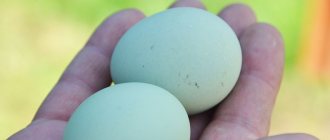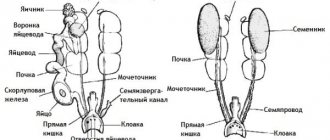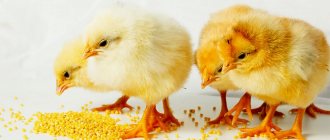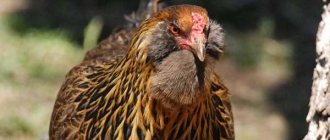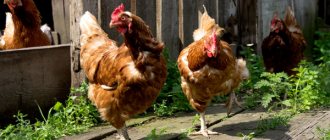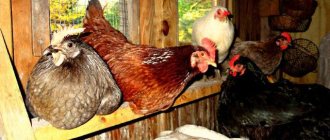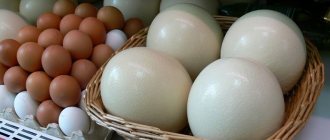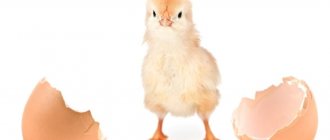Poultry farming » Chickens
1
7557
Article rating
Kira Stoletova
Raising chickens is a profitable business, the main benefit of which is the production of eggs and meat. These products have become so integrated into our diet that it is very difficult to imagine our life without them. But breeders have always been interested in the question, how many years do chickens lay eggs and do the flock lay eggs every day with proper care and proper maintenance?
How many years do chickens lay eggs at home?
Eggs and meat are rich in various beneficial microelements: vitamins and amino acids. In addition, the chicken egg itself is 98% digestible by the human body, which is why these products are so valued among the people. Having decided to keep laying hens at home, you need to know not only about the features of caring for them, but also how many years the hens lay eggs.
When do chickens start laying eggs?
Egg laying is a physiological process that indicates the sexual maturity of a chicken. Wild chickens lay eggs from 6 months of age. The development of egg breeds has led to the appearance of laying hens, which begin to lay eggs at 4-5 months:
- Leghorn - 4.5;
- Loman Brown - 5.5;
- Dominant - 4;
- Tetra - 4;
- Minorca - 5.
In a year, chickens of egg breeds will lay from 200 to 300 eggs.
Meat and egg breeds lay eggs from 5-6 months. These birds are not egg-laying champions, but they are raised for their balanced meat and egg production.
During the year, meat and egg chickens lay about 170-200 eggs. Laying hens of meat breeds begin to lay eggs at 7-8 months, so it is not profitable to keep them for the sake of obtaining eggs. The annual number of eggs from meat chickens is no more than 120. While the young are growing, their combs are small and pale pink in color. When the hen is ready to lay eggs, the color of the comb turns red and it increases in size.
Description of the breed
The bird is distinguished by thick plumage, due to which it visually looks much larger than its actual mass. The color of the feather can be different: to date, 12 types of dominants have been bred, differing in their color.
The bird's eyes are orange and its earlobes are bright red. Chickens always have slightly smaller earrings than roosters. The scallop is scarlet, leaf-shaped and does not stand out for its large size, standing straight. The beak is yellow.
Dominants have a small head and small wings, a wide back. The tail is raised up. The legs are short and widely spaced, colored bright yellow or orange, making the bird look rather squat.
The most popular color varieties and their characteristic features:
- Brown dominant (D102). It has brown plumage, which is reflected in the color of the eggshell. Males most often have white plumage.
- Blue (D107). The most beautiful variety. The plumage is blue, the head is darker, almost black. The shell is brown. In this species, the sex of the chick can be easily determined by its appearance. Hens are born with dark plumage, and males are striped and have a characteristic white spot on their head. It is worth noting the rapid adaptation of the blue dominant to different climatic conditions.
- Partridge. Brown plumage shimmering in golden tones in the sun. The least egg-bearing subspecies, which performs more of a decorative function.
- Grey-speckled. Externally, the plumage resembles a cuckoo - black and white feathers alternate. High immunity, not afraid of cold.
- Red (D853). Somewhat similar to brown ones, but has a brighter and more saturated color.
- Red striped, or amber. A distinctive feature of the cross is the stripes on the feathers of a characteristic golden-red color.
- Sussex dominant (D104). Traditional white color with dark plumage on the tail and neck. The shell is light brown. Adapts perfectly to various conditions.
- Black. Uniform black coloring and bright red earrings and combs. It is distinguished by good health and the ability to adapt to sudden temperature changes.
The Czech dominant has a very gentle character. The bird does not get into fights and does not create conflicts. Easily and quickly gets used to a person and is not afraid of him. Reacts to human voice during feeding and walking.
The cross does not have a maternal instinct, so reproduction is possible only with the help of humans. There is an exception to this rule - the black dominant subspecies. These birds have partially preserved their maternal instinct: they can hatch eggs on their own and are attentive to their chicks.
The greatest egg production occurs upon reaching the age of one and a half years and lasts until two and a half, after which the indicators begin to fall.
You can buy dominants either in the form of eggs (for hatching yourself in an incubator) or as chicks. If you do not have sufficient skills, it is better to purchase an already strong bird. The minimum age of the chick is 7-10 days; it is better not to take younger ones. During this time, individuals gain enough strength to move.
Czech dominants are raised for eggs. The cross is distinguished by high egg production and taste. Puberty begins early, at the age of 4-5 months, and the hens are already beginning to lay their first eggs. At the same time, the weight gain of the bird itself persists for up to 11 months.
A special feature of the cross is that molting has virtually no effect on egg production. Laying hens continue to lay eggs, only slightly reducing their number.
Although the main purpose of breeding is to produce eggs, cross-breeds are also raised for meat. Chickens gain weight quite quickly and easily, and breeders note their excellent taste.
Young laying hens begin laying eggs at a certain age. How to find out exactly when pullets of laying hens begin to lay eggs, which can affect egg production - read the article. In addition, the influence of breed on productivity has been proven.
What affects egg production
The onset of egg laying is influenced by the characteristics of the breed, as well as:
All of these factors can delay the onset of egg laying. Stress factors for birds are the proximity of a predator, road noise, and a cold chicken coop. Oviposition uses about 40% of the energy that is converted in the body from food.
In the presence of parasites and diseases, the body's strength and resources are spent on fighting pathogens, and the hen simply does not have enough strength to lay an egg.
The eggs of a pullet are smaller in size than those of an adult chicken. During the period from 4 to 6 months, the reproductive system of the chicken begins to form. At this time, she needs increased nutrition and a sufficient amount of calcium to establish the egg-laying process. A lack of calcium forces the body to delay the onset until a later date.
How many days a year do chickens lay eggs?
Chickens of egg-laying breeds can lay up to 300 eggs per year, and therefore they lay eggs almost every day. Representatives of meat and egg breeds lay eggs every other day, and meat breeds lay eggs every 2-3 days. Under factory conditions, egg production is higher, since the conditions affecting productivity are more carefully observed.
A chicken of any breed is born with a large supply of eggs, which allows it to lay eggs throughout its life. The bird's eggs are small; it takes about 1-2 days for the full development of one egg, depending on the breed.
How many years does a chicken lay?
The hen has about 4 thousand eggs in her body, which will last her for 11 years. But in reality, chickens live from 2 to 5 years. This is due to the fact that the egg production of most breeds decreases with age, and the meat becomes tougher. Therefore, farmers plan to replace the productive herd no later than in 3-4 years.
Features of individual breeds:
- The maximum egg production of chickens of egg breeds - Leghorn, Tetra, Minorca - occurs in the first year of life. In the second year, productivity declines by 15% and continues to decline in subsequent years.
- Meat-egg type chickens - Orlovskaya, Plymouthrock, Rhode Island - become maximally productive in the second year and maintain the same productivity until three or four years of age. In this case, adult individuals carry larger testicles than young animals.
Chicken culling
Most often, culling is a problem for novice poultry farmers without experience. In this case, you need to watch the birds. A good laying hen can be seen in the nest almost every day and at approximately the same time of day. The rest of the time the bird is actively looking for food. You can mark such chickens with a tin ring placed on their paw. An actively flying bird has a bright, full comb and earrings. If the birds do not molt, then the feathers should be clean, and the hen itself should not be too fat, since the presence of excess weight complicates the process of laying eggs.
Experienced poultry farmers identify the following important signs of a good laying hen:
How to increase egg production
Under natural conditions, chickens lay eggs only in the warm season, with an abundance of greenery and a varied diet. Therefore, several factors can increase egg production:
- increasing daylight hours in winter with the help of additional lighting of the chicken coop - this factor affects representatives of any breed;
- Most breeds need an insulated, draft-free chicken coop, and laying hens from countries with warm climates require a heated coop for stable egg laying;
- adding yeast to the mash in winter will increase the energy value of the feed.
Proteins, mineral salts and vitamins in the diet have a significant impact on egg laying. In addition, during the period of intensive egg laying, a laying hen needs 2 times more nutrients.
Good and stable egg production of chickens is an aspect that is influenced by many household factors - nutrition, living conditions, stress. By changing them for the better, you can achieve maximum productivity.
Conditions for keeping laying hens - roost, temperature, room cleanliness
In order for egg production to be high, the following rules must be observed:
- A sufficient number of perches should be placed in the chicken coop. One nest is designed for 3-4 birds. Perches should also be placed throughout the room.
- The optimal temperature for the chicken coop is +21 degrees. In winter, it is necessary to use special heating lamps for additional lighting and heating.
- The chicken coop must receive sunlight, so it must have a small window.
- The room is designed for a certain number of laying hens. There should be no more than 6 birds per 1 square meter.
- The litter is changed regularly as it gets dirty. This reduces the risk of harmful microorganisms appearing.
Keeping the chicken coop clean
To maintain the health of the chickens, it is important to carefully monitor the cleanliness of the poultry house and promptly remove droppings and food debris.
Duration of egg production in laying hens
Raising chickens is a profitable business, the main benefit of which is the production of eggs and meat. These products have become so integrated into our diet that it is very difficult to imagine our life without them. But breeders have always been interested in the question, how many years do chickens lay eggs and do the flock lay eggs every day with proper care and proper maintenance?
How many years do chickens lay eggs at home?
Eggs and meat are rich in various beneficial microelements: vitamins and amino acids. In addition, the chicken egg itself is 98% digestible by the human body, which is why these products are so valued among the people. Having decided to keep laying hens at home, you need to know not only about the features of caring for them, but also how many years the hens lay eggs.
How to correctly determine the age of a laying hen?
Farmers who are just starting out in poultry farming often cannot correctly determine the age of chickens at the time of purchase. This is an important point, because its productivity depends on the age of the bird, and this is precisely why they are bought. Knowing just two factors: at what age chickens begin to lay eggs and the actual age of the pullets, you can start a profitable business.
You can tell a good laying hen by her behavior.
Every farmer should know that there are no exact parameters to determine the age of a chicken. There are only some recommendations, which we will discuss below. Inexperienced farmers often make mistakes when determining age, and it’s good if this mistake is for a month, and not for six months. Therefore, if you do not have confidence in your abilities, then it is better to go to the market to buy poultry with experienced people who can distinguish young laying hens from old chickens. If you have to make a choice yourself, use the following tips.
Chicken belly
Feel the belly of the hen; if she is old, her belly will be hard. This determines that the bird is already obese, and therefore does not guarantee high egg production. Remember that a laying hen will have the highest productivity in the first year, so we recommend that you refrain from purchasing chicken with a hard belly.
Crest
The bird is designed in such a way that the greater its productivity, that is, the more actively it rushes, the brighter its crest is colored. That is, a young laying hen’s comb should be bright red and warm to the touch, while an old hen’s comb should be light pink and cold.
Pay attention to the temperature of the scallop; it must be warm. In older individuals, blood circulation is impaired and therefore the comb becomes cold
A young laying hen should have a bright red comb and a yellow beak.
Beak and legs
Young chickens up to one year old are distinguished by the color of their beak. Their beak is a rich yellow color, while over time it begins to fade and in older chickens it takes on a gray tint.
It is also worth paying attention to the hen's legs. The feet of a young hen, which can lay eggs daily, will be smooth with even scales, while the feet of an old hen are already developing corns with cracks that can be distinguished by the naked eye
Activity
The older a chicken gets, the less active it begins to lead. If you throw food into a flock of birds, the young ones in the first rows will grab the best pieces of food, and older individuals will be content with what is left.
The older the chicken, the less active lifestyle it leads.
Weight
Weight is also an important factor in determining the age of a chicken. Young animals cannot weigh much. When purchasing grown chickens for a farm, you can determine their age by the time when the cockerels begin to crow. This usually occurs in the sixth month. There are many methods and folk ways of determining the age of a bird.
Just remember that even the most experienced farmer will not be able to give accurate advice on determining the age of a laying hen. But you don’t need to know this, since chickens are not kept on farms for more than two years, after which young ones are bought, and old ones are processed into stew. After a year, chickens begin to lay eggs less often, so keeping them becomes completely unprofitable.
Watch this video on YouTube
When the birds start flying
One of the most important factors that influences the age at which birds begin laying eggs and how long chickens lay eggs is the breed of the bird. It is most rational to keep egg varieties for such purposes. Such a chicken lays eggs starting from the age of five months. The eggs themselves are small in size, and their color depends on the breed of the bird itself. In addition, products from the first clutches have a large yolk. By 8 months, the weight and size of the eggs increases, and the yolk decreases.
Chickens can start laying eggs earlier. It all depends on the emotional state of the winged ones. Keeping backyard chickens is not an easy task. The breeder should choose a safe, quiet place for them. If the chicken coop is located next to a highway, this may affect the period of egg production, its beginning and duration. In addition, if there are other birds on the farm, this can also negatively affect productivity. Any psychological discomfort is reflected in how many eggs chickens can lay in a day, week and even a year. Therefore, the breeder should fulfill all the necessary requirements so that the laying hens give him the desired profit.
Quality of egg products
Standard store eggs have a significant difference from products obtained from young animals. They are inferior in size and weight, but the quality is always at its best. Over time, the size of the eggs will reach a certain norm and an average weight of 60 grams. It all depends on the breed characteristics of the birds.
In chickens at birth, the supply of eggs is calculated in such a way that it is enough for the entire period of life. How long will it take for the egg to become a full-fledged product? This will take about a day.
The following table will look in more detail at how many eggs and from which groups you can get
| Name | Quantitative indicator for 365 days | Note |
| Egg direction | 170–240 pieces | From leghorns you get up to 340 pieces |
| Meat-egg chickens | 170 eggs | |
| Meat poultry | Up to 120 pieces | This is due to the rapid onset of feather cover change. It is worth noting that the products are larger compared to other breeds |
Conditions for the duration of the bird productivity period
In household conditions, chickens begin to lay eggs early, from 4-6 months.
But the duration of the productive period is difficult to predict. The highest figure - up to 300 eggs per year - is achieved thanks to the individual characteristics of crosses or ordinary breeds. In addition, a lot depends on the correctness of the breeder’s actions. The egg production of poultry is affected by:
- Features of the diet. A balanced diet, including the correct proportion of proteins, fats and carbohydrates, affects the health of chickens. The stronger their immunity, the better their productivity and its duration. In addition, it is important that the food consumed by the bird has a sufficient amount of vitamins and minerals contained in vegetables, herbs, shells and other products.
- Conditions of detention. the chicken coop must be protected from drafts, have ventilation and a heating system, which is necessary for the birds in the cold season. It is also important that feeders and drinkers are installed inside the house so that the birds can have easy access to them.
- Genetic factor. Laying hens that are of the egg breed will lay eggs longer than others. In addition, the characteristics of the bird’s immunity to various diseases, which also affect productivity, are also important.
- Chick hatching period.
How is egg production determined?
We have already found out that, for the most part, the quantity and quality of eggs depends on the origin of the bird. But the conditions of its detention also have some influence. Proper care of poultry can significantly increase its productivity.
Factors that increase the number of eggs laid by a chicken:
- A properly designed chicken coop. The most important thing here is warmth: the room should be heated, and it is better to put a large layer of straw on the floor. It is also important to set up a small outdoor area so that the birds can walk and run freely.
- High quality food. Experienced poultry farmers provide chickens with finely ground food rich in vitamins and minerals.
- Peace and quiet. Stress can have a negative impact on both the mental and physical well-being of a chicken.
- Good lighting. If you extend the daylight hours for the birds by lighting the chicken coop for several hours at night, they will soon get used to it and begin to produce more eggs per day.
Every farmer should know this
In order to properly maintain domestic chickens without losses and problems, you should also know that there are pauses in the egg-laying period.
They can be caused by deficiencies in care and feeding, as well as by immune system characteristics. Often the reason for the interruption of the productivity period is natural molting, which every bird goes through once in its entire life. This process begins at one year of age and continues up to 5 months. Some hens are more susceptible to molting and should be culled. Healthy chickens moult quickly and in patches.
Laying hens can also suffer from painful molting, which also affects productivity. How long such a pause lasts depends on the state of the chickens’ immunity, as well as the actions of the breeder. Most often, the main culprits for this phenomenon are:
- errors in content;
- lack of nutrients in the daily diet;
- stress;
- hormonal imbalances.
Birds kept in domestic conditions also experience an annual molt that takes place in the autumn. The decline in productivity is rapid. Most often, laying hens recover within 30-50 days. Some farmers use a trick, causing their entire livestock to shed on their own. The most favorable period is the end of summer.
In home conditions, the artificial molting method shows a good effect. After the completion of the plumage change, the chicken lays eggs more actively and with better quality. Artificial molting can be caused in different ways (hormonal, zootechnical, etc.). The main thing is to consult a veterinarian before doing this, so that human actions do not lead to irreversible consequences.
Maintaining productivity at the same level
Many factors influence how many eggs a laying hen kept in a household will produce per day, month and year. The breeder himself can influence some of them to his advantage. In order to constantly maintain the level of your own profit, you should systematically change the livestock that is being laid. Old, unproductive birds are culled, leaving only profitable chickens. But replenishment of the brood is no less important. The number of adult chickens that are still laying eggs should not exceed 40% of all livestock. The remaining majority are young animals.
The process of restocking also has its own characteristics, which include:
- The need to keep new chickens isolated from the old stock. Birds may not get along together, and may also become infected with infectious diseases from each other.
- The place where future chickens will live must be cleaned and disinfected; a chicken coop that has been used previously and has not been cleaned is dangerous for young chickens. They may get sick.
- The chicken coop must be equipped with a special aviary for walking. It is best to place it on grass, which laying hens can eat, replenishing their diet with useful substances.
It is not advisable to keep old birds. After 2 years, their productivity declines and the quality of their meat deteriorates. Plus, they eat the same way. As soon as the costs spent on food no longer pay off, individual birds are culled. A novice farmer can also focus on how many months the laying hens have to live. For production purposes, chickens are culled by the age of 11 months. In a household, it is better to do this for up to 2 years.
Signs of impending masonry
A little about egg maturation
It takes a chicken about a day to create one egg.
The article “How Chickens Lay Eggs” describes the detailed process of egg formation. Next we will consider only the main points. The “birth” of a testicle begins with the ovary. The yolk descends into the oviduct, where it is covered with a protein layer. This process is the longest, taking approximately 20 hours.
In the oviductal isthmus, the yolk-white mass is covered with a pre-shell film. And already in the uterus - a full-fledged shell.
The last phase is coating with a protective film. 30-40 minutes after the egg is released through the cloaca, the process starts again.
Number of eggs from different breeds
The first eggs of pullets are modest in size - about 30-45 grams. After 2-4 weeks, their weight reaches 55-65 grams.
Egg-type chickens are capable of producing 250-300 eggs per year. There are also record holders who give much more.
Records of egg-meat birds - 140-180 pieces.
The annual number of eggs from meat layers does not exceed 120-150 pieces.
The article “How many eggs does a laying hen lay per day, month and year” will help you understand the egg production rates of chickens of all types. Including decorative, fighting and singing ones.
How to understand that a laying hen will soon give an egg
To understand whether a particular hen will start laying eggs, you can test it in several ways. This will help determine whether it is worth growing further. Or better yet, send it to slaughter.
The back of a good laying hen is strong and short.
The comb, lobes and earrings are secondary sexual characteristics that change color when the ovaries of chickens are activated. They become bright. And also smooth, soft and warm to the touch.
Pullets preparing to lay eggs have light and tender skin. It differs sharply from the bluish, rough skin with fat of a non-laying bird.
Other signs
During egg production, all the pigment is used to color the yolk. There is not enough for anything else. Therefore, the paws are pale in color. They are widely spaced. 3-4 fingers are placed between them.
Laying eggs requires a lot of effort from the hen. She will replenish lost energy through food. This affects the volume of internal organs of the gastrointestinal tract. And that means the belly too. It becomes big and soft.
Based on the size of the hen's exit hole, it is easy to determine whether she will produce eggs. The cloaca should be moist and soft to the touch. Have increased dimensions and be partially open.
How many years can chickens lay eggs?
These days it’s quite difficult to find a yard that doesn’t have chickens. These birds receive such attention due to their delicious white meat and, of course, a large number of eggs. Any owner needs to take into account how many years chickens lay eggs in order to correctly calculate the opportunities for developing a subsistence economy.
How many years do chickens lay eggs?
When do they start laying eggs?
Obtaining eggs and monitoring this process is not an easy task: it is important to monitor the moment of maturity of the chicken, and how long egg production lasts, as well as select the best breeds.
When choosing birds for your farm, you need to take into account how many years the chickens lay eggs at home. This factor can play a large role in the total annual egg count.
First of all, the start of laying a laying hen depends on its breed. This process occurs individually for everyone, but there is still no significant difference in time.
Start of laying different breeds
It is no secret that meat chickens lay eggs rather poorly. A standard meat bird becomes mature only at 8 months, and the egg production threshold for such a chicken is only 120 eggs per year.
Meat and egg layers are a better option. Their maturation lasts about six months, and their productivity is much higher - up to 200 eggs per year.
The best option is egg-laying chickens. Over many years of agricultural development, scientists have been able to breed chickens that produce the highest quality eggs in large volumes. In addition, their maturation takes extremely little time, however, this is also determined by the breed:
- German Loman Brown lays eggs at 5.5 - 6 months;
- The Black Minorca (Spanish flu) begins to lay eggs at 5 months;
- The Partridge Leghorn lays eggs at 4.5 months, which is a very short period.
- The absolute record holders in this area are chickens of the Czech Dominant breed and the Tetra breed, which even in private conditions produce eggs from 4 months of age.
What to feed chickens so they lay eggs every day
You can take the simplest route and buy complete feed for chickens (PK-1-1 and PK-1-3). This food will fully provide protein, vitamins and minerals. The feed consists of medium and small granules; feed it dry, without steaming or filling it with water. Do not add any additional additives to such food, this will only cause harm. Additionally, chickens can only be given a little greenery.
Feeding with compound feed also has disadvantages:
- short shelf life (no more than 3 months);
- high price (from 30-40 rubles per 1 kg);
- The taste of a homemade chicken egg will not differ from the taste of a store-bought egg.
If you want to give up industrial feed, but maintain livestock productivity at a high level, make your own feed. It will take time and some effort, but the result is worth it.
In order for chickens to lay eggs well, the protein content in the feed should not be lower than 17%, which is ensured by the introduction of cake and fish meal into the feed. The basis of the feed mixture is crushed or rolled grain of wheat, barley, corn, in a ratio of 1:0.5:1. Add to this mixture:
- 10% wheat bran;
- 8% sunflower cake;
- 4% fish or meat and bone meal;
- 0.5% table salt.
Shell rock or chalk is added to the finished mixture in an amount of 2% of the total weight of the feed, and a premix (Zdravur, Ryabushka). The premix contains a complex of vitamins; it is especially necessary in winter, when the herd sits indoors.
Do you add premixes to the food?
Not really
In summer, give plenty of greens in a separate feeder. In winter, feed hay crushed into flour 5-8 g per head per day.
The norm for feeding the grain mixture with all additives per chicken is 120-150 g per day. Do not exceed this norm so that the hen does not become fat. Feed can be given to chickens in the form of wet crumbly mash, with the addition of food waste, dairy products, and vegetables.
Do not give your chickens salty, sweet or spicy foods, this can lead to poisoning!
Laying hens are fed at home twice a day.
How many years have they been rushing?
The average lifespan of an ordinary bird is 10 years, of course, provided that it is not slaughtered for meat. However, the ability to lay good eggs drops by 15% every year.
In general, chickens lay eggs for about 3-4 years, again, depending on the breed.
Some species, for example, Rhode Island, emerge as excellent layers only in the second year of life. They are able to lay many eggs for much longer, which is why they are popular among breeders.
In general, chickens lay eggs for about 3-4 years.
How to properly cull chickens
For newcomers to this business, such a question can lead to a dead end. Professionals say that for productive keeping of birds at home, every year it is worth keeping 60% of newly arrived hens among active layers. Only 40%, including the best representatives of the chicken coop, should remain for the 2nd year.
Signs of a good layer:
- Health is the first and most important thing you need to pay attention to. The chicken should be healthy, look well-fed and clean.
- Lack of excess weight (excess fat has a detrimental effect on egg production).
- Having a clear daily routine - a smart hen with maternal instincts will spend a lot of time in the nest and only during certain periods of her day.
Possible problems with egg production and their solutions
The egg production of pullets depends on many factors. If it has decreased, then it is necessary to identify the problem and solve it.
Shedding
This process means that the chicken's feather cover is completely renewed. Shedding begins from the head, gradually moving towards the tail. During this period, egg production may drop significantly and stop altogether.
For pullet hens, this is already the third molt; it begins in the spring (the first two moults take place in the 1st and 3rd months of life). In the future, the bird will moult annually in the fall. The process can take 1-1.5 months, but sometimes it drags on. You can speed it up and restore egg production by the following steps:
- exclusion of tactile contact;
- increasing protein content in the diet;
- ensuring free range;
- exclusion of cold weather;
- avoiding any stress.
After molting, there is a risk of false layers appearing. Such chickens do not lay eggs at all, so they need to be culled. A distinctive feature of false layers is the presence of a cock's comb and a small distance between the ischial bones.
Conditions of detention
The egg production of chickens drops if the bird is not warm enough or there is not enough light. In summer, indicators increase significantly as the ambient temperature rises and the length of daylight hours increases.
In the autumn-winter period, a decrease in egg production can be avoided by ensuring the following conditions:
- temperature not lower than 18 degrees;
- optimal humidity level – 55-65%;
- Daylight hours are approximately 17-18 hours.
Artificial lighting should not be too intense - up to 20 Lux is enough.
The sanitary condition of the premises is of great importance for egg production and the health of chickens. It is necessary to exclude dust, monitor the cleanliness and dryness of the bedding, and the comfort of the nest.
How to make a perch for chickens with your own hands is described in the following article.
Features of feeding
Another factor influencing the egg production of chickens of any age is feeding habits. The feed should contain approximately 15-17% protein. With its deficiency, egg production decreases.
There may be a problem such as egg casting. This is the name given to the situation when a laying hen produces eggs without a shell - in liquid form it can be eaten by the chicken or lost on the litter. This happens due to a lack of calcium. This problem is called a false decrease in egg production.
Another negative factor is the lack of water. Layers can be given water in doses or freely - in any case there should be enough water. During dosed drinking, water is given with food. It is important to remember its quality. You can make a drinking bowl yourself, or you can buy a ready-made one.
Diseases
In a sick bird, egg production decreases. It can be considered zero, since in most cases the product is simply not suitable for use and requires disposal. Egg production may decrease due to the following diseases:
- Infections. The percentage of productivity loss depends on the specific disease; after treatment, egg production is restored by an average of 75%. With infectious bronchitis, there is a risk of a chronic course of the disease and pathology of internal organs, which can lead to a complete and irreversible loss of productivity.
- Non-communicable diseases. Such diseases are usually inflammatory in nature: salpingitis, peritonitis, ovarianitis. Individual individuals suffer, egg production decreases or becomes zero.
Treatment of chickens should be carried out under the supervision of a veterinarian. The cause of disease often lies in improperly organized poultry housing or its nutrition - errors need to be identified and corrected. For a more complete review of chicken diseases, see here.
Rats
This is one of the major problems in a chicken coop. Rats carry eggs, leading to a stressful state of the bird, against the background of which egg production may decrease. The risk of diseases that these rodents carry is also high.
It is imperative to get rid of rats in the chicken coop. You can do this in the following ways:
- Ultrasonic repeller. This option is good for humane people who do not want to kill rodents. Birds and people do not perceive the sounds of the repeller, but for rats it is extremely uncomfortable. Depending on the size of the chicken coop, you can choose a suitable household or industrial device.
- Mechanical obstacle. This should be taken care of during the construction stage of the chicken coop, but the finished premises can also be improved. All holes and cracks must be sealed, protection made of fine mesh or sheet iron (should go half a meter into the ground), and nests located high up.
- Smells. Rats do not like the smell of burnt fur, cat hair and some plants (ledum, mint, nightshade, elderberry, onion). Plants must be used carefully, as some of them are poisonous to chickens, so they should be placed in places inaccessible to birds.
- Chemicals. This is poison and various substances that are sprayed into the air. The second option involves the use of chlorine, carbon monoxide, and hydrogen phosphide. Such methods are used by experienced disinfectors; they are appropriate for large farms and on an industrial scale. Poison can include various powders, granules, baits. The negative point is the danger of poisoning for other animals, birds and even people. This risk can be reduced by organizing special traps.
- Cats and dogs. Certain breeds of such animals are excellent rat catchers, but to preserve egg production it is important that they do not disturb the chickens.
- Cannibalism. This method is cruel - you need to catch one or more rats and keep them locked up from hand to mouth. Because of hunger, they will engage in cannibalism - they will destroy their own relatives. At the same time, the danger for chickens may remain.
Egg production is one of the most important indicators of the effectiveness of pullets, especially when they are bred specifically for such purposes. The timing of egg laying and its duration depend on the breed of bird and the characteristics of its keeping. You can increase egg production by taking certain actions. If it decreases, the problem must be identified and solved.
0
0
Copy link
